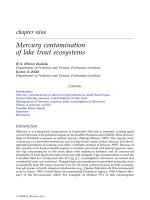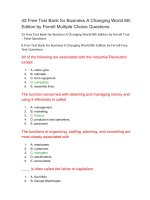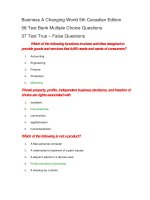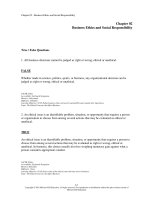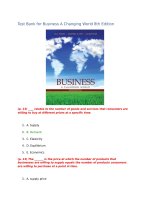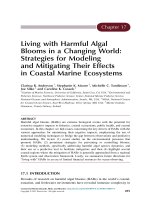Lecture Business: A changing world - Chapter 9: Production and operations management
Bạn đang xem bản rút gọn của tài liệu. Xem và tải ngay bản đầy đủ của tài liệu tại đây (2.13 MB, 27 trang )
Chapter Nine
Production and
Operations Management
© 2003 McGrawHill Ryerson Limited
Operations Management
9-1
The development and administration of
the activities involved in transforming
resources into goods and services.
© 2003 McGrawHill Ryerson Limited
The Transformation Process
Inputs
land
labor
capital
raw
materials
time
information
energy
9-2
Transformation
or Conversion
procedures
equipment
facilities
technology
knowledge
Control
standards
Customer
© 2003 McGrawHill Ryerson Limited
Outputs
goods
services
ideas
(Feedback)
Inputs, Outputs, and Transformation
Processes in the Manufacture
of Oak Furniture
9-3
Inputs
oak trees
labour
information/
knowledge
stain or varnish
router/saw
warehouse
space/time
Transformation
cutting or
sawing
routing
measuring
assembling
staining/varnishing
storing
© 2003 McGrawHill Ryerson Limited
Outputs
oak furniture
Operations in Service
Businesses
• Service providers use human and mechanical
processes to provide products that are
intangible.
• The transformation process requires inputs
such as employees, equipment and supplies.
• Outputs provide a benefit from a
performance, event or type of involvement
with the service provider.
9-4
© 2003 McGrawHill Ryerson Limited
Differences between Manufacturers
and Service Providers
•
•
•
•
•
9-5
Nature and consumption of output
Uniformity of inputs
Uniformity of outputs
Labour required
Measurement of productivity
© 2003 McGrawHill Ryerson Limited
Steps in Planning and Designing
Operations Systems
9-6a
1. Planning the product
2. Designing the operations process
a. standardization
b. modular design
c. customization
3. Planning capacity
© 2003 McGrawHill Ryerson Limited
Steps in Planning and Designing
Operations Systems
9-6b
4. Planning facilities
a. facility location
b. facility layout
1. fixed position layout
2. process layout
3. product layout
c. technology
1. CAD
2. CAM
3. flexible manufacturing
4. CIM
© 2003 McGrawHill Ryerson Limited
Facility Layouts
9-7
Fixedposition layout
All resources needed for a
product are brought to a
central location.
Process layout
Layout is organized into
departments that group related
processes.
Product layout
Production is broken down into
relatively simple tasks assigned
to workers positioned along a
line.
© 2003 McGrawHill Ryerson Limited
Logistics
Purchasing
9-8
Inventory Control
Routing and Scheduling
Distribution
© 2003 McGrawHill Ryerson Limited
9-9
PBB Global
Logistics Provides
Integrated
Solutions
© 2003 McGrawHill Ryerson Limited
Types of Inventory
9-10
raw
raw
materials
materials
work in
work in
process
process
transformation process
© 2003 McGrawHill Ryerson Limited
finished
finished
goods
goods
Managing Inventory
9-11
• Economic order quantity (EOQ)
model
• Justintime inventory management
(JIT)
• Materialrequirements planning (MRP)
© 2003 McGrawHill Ryerson Limited
9-12
Roadway Assists
with Transportation and
Inventory Management
© 2003 McGrawHill Ryerson Limited
A Hypothetical PERT Diagram
for a McDonald’s Big Mac
9-13
Start
Grill beef
patties
(120)
2
Remove buns,
2 beef patties,
cheese,
sauce,
1
lettuce,
onions,
pickle
(20)
4
Place
cooked
patties
on bun
(5)
3
Apply
sauce
to bun
(10)
Critical path
Activity
© 2003 McGrawHill Ryerson Limited
6
5
Top
with
cheese
and
vegetables
(15)
7
Place
Big Mac in
package
(5)
5
Event
8
Place
package
in heated
bin
(5)
E
n
d
Serve to
customer
(5)
(185) Time to complete
event (seconds)
National Quality Institute
Principles of Business Excellence
9-14a
1. Leadership through involvement
2. Primary focus on stakeholders/customers
and the market place
3. Cooperation and teamwork
4. Prevention based on process management
© 2003 McGrawHill Ryerson Limited
National Quality Institute
Principles of Business Excellence
9-14b
5. Factual approach to decision making
6. Continuous learning and people
involvement
7. Focus on continuous improvement
8. Fulfillment of obligations to all
stakeholders and society
© 2003 McGrawHill Ryerson Limited
Total Quality Management
9-15
A philosophy and set of guiding
principles that provide a foundation
for the continuous improvement of an
enterprise.
© 2003 McGrawHill Ryerson Limited
Enterprise Resource Planning
9-16
The integration of all departments
and functions of a company into one
computer system
© 2003 McGrawHill Ryerson Limited
IS0 9000
Internal Organization for Standardization
9-17
• Designed to ensure consistent quality
• Requires documenting record keeping on
training, testing and responding to defects
• Independent auditor must verify standards
required by ISO
• ISO 9002 certification has been established
for service providers
© 2003 McGrawHill Ryerson Limited
Solve the Dilemma
9-18
What mistake did McKing make in
approaching the introduction of pizza? How
could this product introduction have been
coordinated to avoid the problems that were
encountered? If you were an executive at
McKing, how would you proceed with the
introduction of pizza into the restaurants?
© 2003 McGrawHill Ryerson Limited
Explore Your Career Options
9-19
How can an understanding of total
quality management (TQM) or ISO 9000
series certification assist in developing a
career?
© 2003 McGrawHill Ryerson Limited
Additional Discussion
Questions and Exercises
9-20a
1. What is the purpose of inventory control?
2. PERT charts can show a sequence of activities in days rather than seconds.
Draw a PERT chart for the chairperson of a banquet committee showing the
most efficient path for these projected events:
January 5
Confirm banquet room reservation.
January 6
Publicize banquet.
January 19
Count number of banquet reservations; phone in total to hotel.
January 20
Phone chairpersons of banquet decorating committee and
hospitality committee to review preparations for banquet.
© 2003 McGrawHill Ryerson Limited
Additional Discussion
Questions and Exercises
9-20b
Question 2 continued.
January 27
Decorating committee places decorations on tables.
(24 p.m.)
Hospitality committee prepares registration table and banquet
booklets.
January 27
(6 p.m.)
Banquet
January 30
Send thankyou notes to all committee persons and hotel staff.
© 2003 McGrawHill Ryerson Limited
Additional Discussion
Questions and Exercises
9-20c
• 3. Prepare a Gant Chart for the
sequence of activities described in
question #2
© 2003 McGrawHill Ryerson Limited
